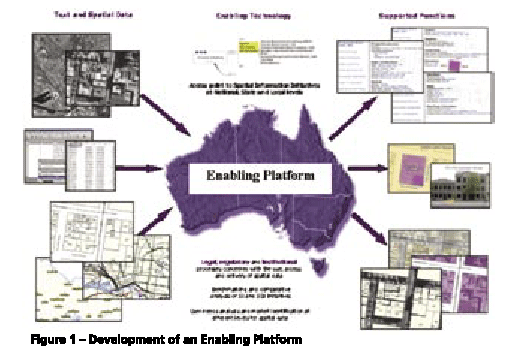| SDI | |
Developing a platform to facilitate sharing spatial data
|
||||
|
Users of positioning and spatial information services and tools require precise spatial information in realtime and real-world objects. Simply an accurate positioning of a future subdivision is no longer accepted, users require it to be visualized as well, in order to take into account outside in?uences. The capacity to meet such user needs and deliver services and tools within the spatial information market has gone beyond the ability of single organisations (Rajabifard, et al, 2005a). There is now a wide range of products and services available for a wide range of IT applications, and hence the development of an enabling platform can facilitate access to data and sharing resources and tools among different practitioners. The creation of an enabling platform for the delivery of these tools and positioning applications will allow users from diverse backgrounds to work together with current technologies to meet the dynamic market place. Up until now, individual jurisdictions within Australia for example have started utilizing different platforms in attempting to create mechanisms for accessing and delivering spatial data and associated applications and tools in a coordinated fashion. This has been done through the use of hierarchies of information, where jurisdictions utilize information both by those within a jurisdictional level as well as those at a higher or lower jurisdictional level. The benefits of this sharing of information have been documented, however they do not necessarily break down the barriers between jurisdictions. Just because different information can be gained about Victorian state for example from different jurisdictional levels, does not mean that the information will necessarily be compatible (it may not be of the same accuracy or have the same specifications, utilize the same symbology, etc) (Rajabifard, et al, 2005b). There is now a need to create a common rail gauge within Australia to aid in implementing initiatives which solve crossjurisdictional and national issues. In order to meet this need, there is a requirement for an enabling platform. What is an enabling platformThe development of an enabling platform for a country or a jurisdiction will enhance the capability of government, the private sector and the general community in engaging in systems based, integrated and holistic decision making about the future of that jurisdiction. Applications, tools, and different sorts of information would be available through the platform to build a view of, query and allow decisions to be based on, both the built and natural environments. This platform must also include the administration and institutional aspects of such features, enabling both technical and institutional (eg. policies) aspects to be incorporated into decision-making. This is an aspect of research identi?ed as more challenging than complex technical issues (Rajabifard, et al, 2005a). The development of an enabling platform is being investigated within Australia by researchers in the Department of Geomatics, at the University of Melbourne. As part of this, an investigation within Australia of various spatial information initiatives has been undertaken in order to identify potential concepts and principles to facilitate the development of an enabling platform such as Virtual Australia. Overall, development of data sharing and access mechanisms for each jurisdiction was the major driving force in the majority of government activity at state and national level in Australia. This aims to reduce duplication of effort and expense occurring in creating data, infrastructure and a framework for data sharing throughout jurisdictions at all levels. A lack of effective interaction between the traditionally strong land and property information focus of spatial information with management of the natural resources, scientific information and socio-economic information was also an issue. State Governments in particular however are addressing these issues through the creation of whole-of-government spatial information initiatives which, when appropriate jurisdictional and institutional practices in place, would contribute to and link off an enabling platform. The development of National initiatives such as Australia’s Ocean’s Portal and the Australian Disaster Information Network (AusDIN) along with the development of state based land information systems all have similar aims to that of the creation of an enabling platform – making information and applications widely available to users. As Figure 1 shows, an enabling platform is an infrastructure that supports a knowledge base to access information derived from a model of integrated datasets from different disciplines such as the natural and built environments. It can comprise of individual organizations or partners working as a collaborative network to deliver specialized products and services for various applications such as animal and disease control and counter terrorism, on the basis of common standards (like OGC) and business understanding, creating distributed functions within the organisations (Radwan et al. 2003). It can also support ready access to applications of spatial information to support decision making at different scales for multiple purposes. It could be viewed as an infrastructure linking data users and providers on the basis of the common goal of data sharing across jurisdictions. The creation of an enabling platform for access to information and technology would help to lower barriers to access and use of spatial information and tools within the spatial information industry. This lowering of barriers will enable industries to concentrate on their core business objectives to greater effect, would reduce duplication of effort, reduce costs and encourage investment in capacity for generating and delivering a wider range of products and applications (CRC, 2005). |
||||
Pages: 1 2















 (36 votes, average: 1.25 out of 5)
(36 votes, average: 1.25 out of 5)



